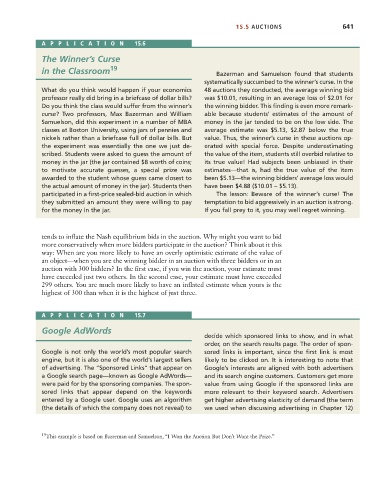Page 667 - Microeconomics, Fourth Edition
P. 667
c15riskandinformation.qxd 8/16/10 11:10 AM Page 641
15.5 AUCTIONS 641
APPLICA TION 15.6
The Winner’s Curse
in the Classroom 19 Bazerman and Samuelson found that students
systematically succumbed to the winner’s curse. In the
What do you think would happen if your economics 48 auctions they conducted, the average winning bid
professor really did bring in a briefcase of dollar bills? was $10.01, resulting in an average loss of $2.01 for
Do you think the class would suffer from the winner’s the winning bidder. This finding is even more remark-
curse? Two professors, Max Bazerman and William able because students’ estimates of the amount of
Samuelson, did this experiment in a number of MBA money in the jar tended to be on the low side. The
classes at Boston University, using jars of pennies and average estimate was $5.13, $2.87 below the true
nickels rather than a briefcase full of dollar bills. But value. Thus, the winner’s curse in these auctions op-
the experiment was essentially the one we just de- erated with special force. Despite underestimating
scribed. Students were asked to guess the amount of the value of the item, students still overbid relative to
money in the jar (the jar contained $8 worth of coins; its true value! Had subjects been unbiased in their
to motivate accurate guesses, a special prize was estimates—that is, had the true value of the item
awarded to the student whose guess came closest to been $5.13—the winning bidders’ average loss would
the actual amount of money in the jar). Students then have been $4.88 ($10.01 – $5.13).
participated in a first-price sealed-bid auction in which The lesson: Beware of the winner’s curse! The
they submitted an amount they were willing to pay temptation to bid aggressively in an auction is strong.
for the money in the jar. If you fall prey to it, you may well regret winning.
tends to inflate the Nash equilibrium bids in the auction. Why might you want to bid
more conservatively when more bidders participate in the auction? Think about it this
way: When are you more likely to have an overly optimistic estimate of the value of
an object—when you are the winning bidder in an auction with three bidders or in an
auction with 300 bidders? In the first case, if you win the auction, your estimate must
have exceeded just two others. In the second case, your estimate must have exceeded
299 others. You are much more likely to have an inflated estimate when yours is the
highest of 300 than when it is the highest of just three.
APPLICA TION 15.7
Google AdWords
decide which sponsored links to show, and in what
order, on the search results page. The order of spon-
Google is not only the world’s most popular search sored links is important, since the first link is most
engine, but it is also one of the world’s largest sellers likely to be clicked on. It is interesting to note that
of advertising. The “Sponsored Links” that appear on Google’s interests are aligned with both advertisers
a Google search page—known as Google AdWords— and its search engine customers. Customers get more
were paid for by the sponsoring companies. The spon- value from using Google if the sponsored links are
sored links that appear depend on the keywords more relevant to their keyword search. Advertisers
entered by a Google user. Google uses an algorithm get higher advertising elasticity of demand (the term
(the details of which the company does not reveal) to we used when discussing advertising in Chapter 12)
19 This example is based on Bazerman and Samuelson, “I Won the Auction But Don’t Want the Prize.”

